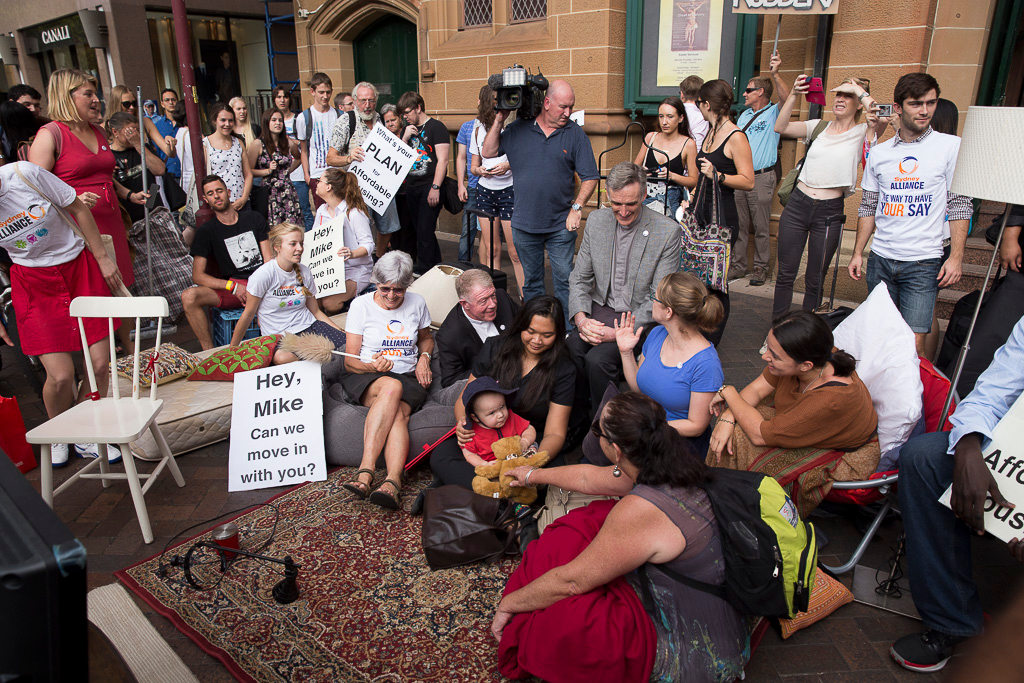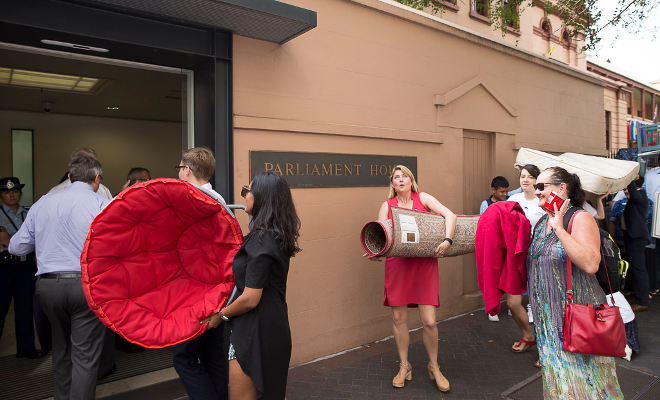Protesters Brought A “Pop-Up Share House” To NSW’s Parliament, To Draw Attention To The Housing Crisis
The housing affordability crisis affects Australia’s youth more than any other age group. And even if you’re making rent, it’s affecting your standard of living.

Are you experiencing financial or housing stress? Why not move in with NSW Premier Mike Baird?
This morning at NSW Parliament House, around 70 protestors unloaded lamps, a mattress, chairs and bean-bags from a removalist, to “move in with Mike”. The protestors began at the corner of George Street and Martin Place, before marching down Macquarie Street at 9:30am to set up camp, TV and all.
“Together we want to make sure that politicians no longer avoid addressing the problem of housing affordability,” Sydney Alliance community organiser Samara Barchet said. She said this action was one of many organised by their group and others over the next fortnight, to demonstrate the diversity of people who want to see action on housing.
–
The Housing Crisis, And How It Affects You
The housing affordability crisis affects Australia’s youth more than any other age group. And even if you’re making rent, it’s affecting your standard of living.
A 2012 study found that young people aged 15-24 are at twice the risk of experiencing housing stress than the general population, with one in five people in that age bracket (66,440) paying more than 30% of their income on housing.
Scarier still? One in four Australians between the ages of 24 and 35 now live with their parents.
These figures are unprecedented, and the causes behind it are varied, but they begin at the top of the ladder. Anglicare Australia described it best:
“With a housing supply gap of just under 300,000 dwellings, a lot of first home buyers are out-competed by investors with a greater capacity to purchase in the market. This group of would-be home buyers are squeezed out of the buyer’s market and must resort to renting for the foreseeable future. With their more comfortable incomes, they can afford to pay for higher quality rental properties, which would usually be occupied by people on the next lower income tier. As the domino effect plays out, and due to the basic laws of supply and demand, people on this income tier have no choice but to rent lower quality properties, but still pay a higher price for it due to significant demand in the rental market.
The downward pressure continues until people living on the lowest incomes of our society are totally priced out of the market.”
Rent in capital cities rose at twice the rate of inflation between the years 2006 and 2011, as the minimum wage draws ever closer to the weekly rental price. We’re left with a situation where, according to Anglicare’s report, less than 1% of all rental properties listed nationally are affordable for anyone on government payments.
The ABC recently reported that the average wealth of 65-74 year-old households rose by $215,000 over eight years. But the wealth of 25-34 year-olds actually went backwards over the same period, leaving Australia’s younger generations among the most affected by the housing crisis. Not to mention our retirement will likely be less than second rate, without the security of a home.
Ergo: world is fukt. And for some more than others.
Those who are young are vulnerable, but so too are those who are Indigenous, from a non-English speaking family, disabled, or living outside major cities. And for people on the lowest rung of the socio-economic ladder, there are fewer and fewer places to turn.
The number of public housing properties shrank by 22,900 between the years 2000 to 2010, while the population grew by 2.88 million, 58% of those seeking accommodation between 2009-10 were turned away, with 173,000 Australians on public housing waiting lists by 2011. Basically, there are way more people in need of affordable housing than we have affordable houses.
“The problem is more nuanced than simply increasing supply, though,” Barchet says. “If we only build a lot of houses in Western Sydney or in regional areas, it doesn’t address the urban planning issue of housing near where people work … Addressing the problem requires supply in inner city and suburban areas, as well as in new suburbs.”
How lucky we are, then, to have governments that care so deeply for the disadvantaged when it comes to these types of issues. Ha. Ha. Ha. :(
The truth is, no government in recent history, be it state or federal, has fully grappled with the growing housing crisis. Successive governments have been so impotent on the issue that a 2006 United Nations Special Rapporteur on the Right to Housing found Australia had “failed to implement its legal obligation to progressively realise the human right to adequate housing, particularly in view of its responsibilities as a rich and prosperous country.” (Australians are, like, so sick of being lectured by the UN, though.) Meanwhile, rent has increased at a greater rate than the Commonwealth Rent Assistance, leaving us to again pay a higher proportion of our income on rent. Fukt.
–
We Need Action Now
Between the selling off of waterfront public housing, the tenuous situation at Redfern’s The Block, the abolition of the National Rental Affordability Scheme, the closure of women’s refuges, and Premier Baird’s recent announcement that drug dealers will be evicted from public housing, politicians are only worsening this issue. Where is there to turn, once evicted from public housing, but further into poverty? Won’t disenfranchising the already disadvantaged actually add to their poverty, and therefore their government dependency?
Anyone? …Bueller?

We should not settle for paying more of our incomes on housing each year. We shouldn’t need to scrape by, or skimp on necessities. Changes can be made. Heck, even the folks over at The Australian have suggested introducing a land tax and GST exemptions for not-for-profits that place low-income earners in housing.
Barchet and the Sydney Alliance were nonetheless pleased with NSW Labor’s Luke Foley’s plan for a five year delayed repayment on stamp duty. But ultimately, they hope each side of government will “announce an affordable housing plan with targets for the next term of government.” Like Barchet suggested, a shared equity scheme with shared homeownership between a provider and an individual, as well as a shift away from stamp duty towards a HECS-style debt, with delayed repayment, would be a welcome first step.
And if Baird and Foley don’t deal with it, they’d better get used to young Australians bunking with them — because as Barchet says, Australia’s young people tend to be ignored “unless they force themselves into the conversation.”
So: anyone up for moving in with Mike? He probably has a pretty sweet pad in the cushy seat of Manly, with working amenities and everything. He can probably even afford three meals a day for his family — and me! Bet he can afford rent. Bet he can afford mine. But he’s probably a sucky housemate. “I’d be worried about how he’d handle doing the dishes, given his approach to housing affordability is just to pile up more and more [problems],” Barchet says.
I hear that.
–
Rachel Eddie is a Sydney-based freelance writer, and past editor of Vertigo. You can follow her on Twitter at @heyracheddie
Feature photo © Bodhi Liggett, 2015


